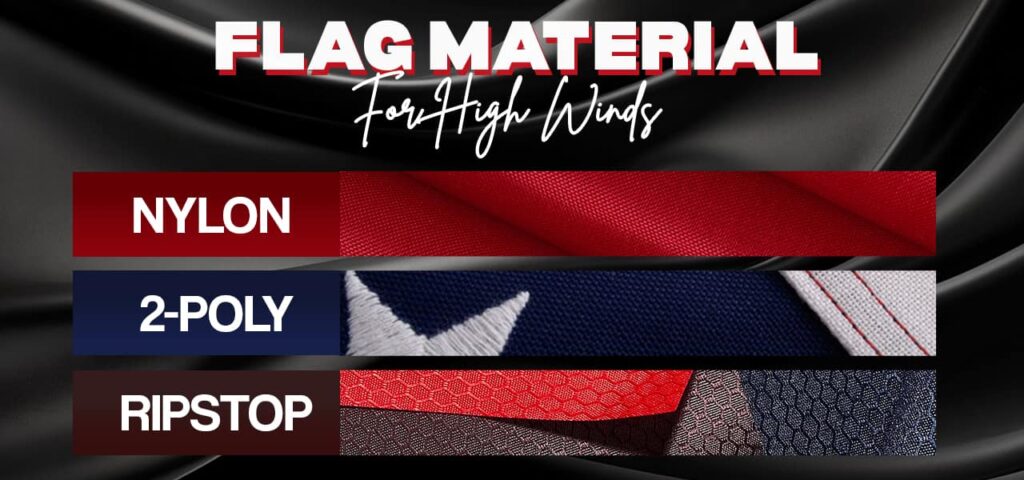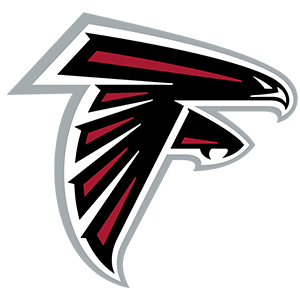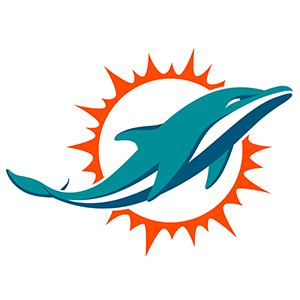News
Best Flag Material for High Winds: What Actually Lasts Outdoors (FlagOh)
Wind shreds flags fast—unless you specify by Beaufort scale, denier/GSM, and seam density (SPI). This guide shows how to pick the best flag material for high winds—when to choose 2-ply polyester vs tight-weave nylon—and which build + hardware choices actually extend life.

Best Flag Material for High Winds
For most coastal or open-terrain setups (Beaufort B6–B7 sustained), the best flag material for high winds is 2-ply spun polyester with reinforced fly ends; in salt-spray / high-UV zones, inspect more often and confirm your bracket’s torque class matches the flag’s sail area. In lighter, gusty conditions (B4–B5), tight-weave nylon flies sooner thanks to higher porosity and quick dry-time.
At-a-glance recommendations
| Use case | Recommended fabric | Key features | Helpful specs |
| Coastal/constant wind | 2-ply spun polyester | Triple-stitched fly end, bar-tacks, canvas header, brass grommets | 150–200 GSM, 8–12 SPI seams, 3–5 bar-tacks at stress points |
| High-rise/roofline corridor | 2-ply polyester (size down) | Reinforced corners, heavy-duty pole & bracket | Through-bolt brackets into studs or use rated masonry anchors; stainless or hot-dip galvanized fasteners |
| Gusty suburb/garden | Tight-weave nylon | Sleeve mount + anti-wrap rings, UV-resistant thread | Flies in an 8–12 mph (13–19 km/h) breeze |
| Event/parade (short use) | Ripstop nylon/poly blend | Light mass, bold graphics | Easy fly; best for intermittent display |
Lock your choice by checking pole/bracket ratings against your flag’s sail area; overspec hardware by one class if your site sees B6–B7 bursts.
Wind Ratings & Standards (Beaufort, ASTM, and what the specs mean)
Why it matters: Real-world wind isn’t just a mph guess; use the Beaufort scale and fabric tests to match build to stress. Higher tensile (ASTM D5034) + tear (ASTM D2261) and lower CFM resist fray; watch denier, GSM, SPI, lockstitch/bar-tacks, and a stout header/sleeve fit.
Rule-of-thumb matrix
| Beaufort | Plain-English wind | What to pick | Notes |
| B4–B5 | 13–24 mph breezy | Tight-weave nylon | Flies early; good porosity for gusts |
| B6–B7 | 25–38 mph strong | 2-ply polyester | Shorten hoist length or switch to a 2:3 aspect ratio to reduce sail without shrinking iconography. |
| B8+ | 39+ mph gale | Heavy 2-ply poly or pause display | Hardware bracket rating becomes a limiting factor |
What to request from the vendor: recent ASTM D5034/D2261 test report, fabric porosity (CFM) note, and a written wind-use warranty for your size bracket.
Set your pick, then make it stick: confirm exposure by Beaufort range, pair the fabric with hardware that meets the flag’s sail-area demands, and choose sizing/aspect ratio that keeps load and legibility in balance. Log the install date, schedule quick monthly checks, and re-torque after storms—small habits that keep a high-wind setup flying clean and bright for months.
Best Material for Outdoor Flag
Outdoors rarely means wind alone. When choosing the best material for an outdoor flag, match it to sun/UV, rain & humidity, salt spray, and freeze/thaw so your outdoor flag keeps color and shape longer.
- High UV/desert: solution-dyed nylon or 2-ply polyester with UV inhibitors.
- Coastal/salt spray: stainless hardware and corrosion isolation; rinse salt periodically.
- Frequent rain/freeze–thaw: quick-dry nylon; avoid water-logged fabrics in freezes.
- Urban wind tunnels/high-rises: prioritize reinforced seams and bar-tacks over fabric type.
Let climate drive the spec: choose for the harshest condition, log install date and fabric, and do quick monthly checks (fly end, header, clips, bracket fasteners). Keep one spare for rotation during peak seasons, and re-torque hardware after storms or big temperature swings. If conditions change seasonally or on trips, adjust the setup to keep color and shape longer.
Materials That Survive Wind: How They Differ
Choosing the right fabric is half the battle in high wind. This section compares how 2-ply polyester, tight-weave nylon, and ripstop blends behave in real gusts—what the specs (GSM, denier, weave density) actually mean, and when each material makes sense if you’re chasing the best flag material for high winds. We’ll also touch on tensile and tear strength and fabric porosity (air-through rate) to explain why some flags last longer
Nylon (e.g., 210D tight-weave)
- Why it lasts: Nylon’s elastic recovery and lower water uptake help it snap back from gusts and dry quickly after rain. Because it lifts in lighter wind, it flutters less desperately to “find air,” reducing stress on seams in moderate conditions.
- Pros
- Lifts in low–moderate wind; great all-season porch choice
- Quick-dry after storms; vibrant dye-sub logos
- Lighter mass = less load on bracket/pole
- Cons
- In gap winds/corridors, it can “whip”; it needs good hems
- UV resistance is decent but not class-leading vs polyester
- For heavy double-sided builds, bracket rating becomes more important
- Useful numbers
- Typical weight window: ~110–140 GSM (for 210D tight-weave nylon)
- Best wind band: B4–B5 (≈13–24 mph) daily use
- Hem spec to aim for: 8–12 SPI lockstitch at the fly end; 3–5 bar-tacks at stress points
2-Ply Polyester (150–200 GSM)
- Why it lasts: Two layers of heavier, abrasion-resistant yarns spread load at the fly end and resist fray in sustained B6–B7 winds. Polyester’s strong UV stability also slows fade in high-sun exposures.
- Pros
- Best durability profile for windy sites
- Pairs naturally with blackout liner for double-sided true-read
- Colorfast and stable under long sun windows
- Cons
- Heavier; confirm bracket/pole rating and anchors
- Needs a bit more breeze to lift vs nylon
- Longer dry time than nylon after soaking in rain
- Useful numbers
- Fabric mass: 150–200 GSM (sweet spot for 2-ply)
- Best wind band: B6–B7 (≈25–38 mph) sustained/gusty
- Keep same seam targets: 8–12 SPI lockstitch, 3–5 bar-tacks; header height ≈1.5–2 in
Ripstop & specialty builds
- Why it lasts: The tear-stop grid arrests small rips before they run; specialty weaves and heat-set finishing reduce edge curl and seam creep.
- Pros
- Enhanced snag resistance; good around trees/rails
- Can balance lift vs durability with the right grid and finish
- Cons
- Some thin ripstops trade mass for lift—fine in light wind but not a cure-all
- Still lives or dies by stitch density and fly-end reinforcement
- Useful numbers
- Common grid pitch: ~3–5 mm
- Target a firm header and bar-tack count as above; don’t accept chainstitch on the fly end
Specs that actually matter
These are the specs that predict service life better than the marketing name on the hangtag:
- GSM/denier → Practical signal for yarn heft and stretch resistance. Heavier GSM usually means better fray resistance, but more load on hardware.
- Porosity (CFM) → How easily air passes through the fabric. Lower CFM = more “sail” (needs stronger seams/hardware, lifts later). Higher CFM = lifts earlier but may show less print opacity.
- Heat-set & finishing → Stabilized fibers = tighter edges, less curl, and cleaner logo outlines over time.
Pick nylon in B4–B5 for lift/quick-dry; pick 2-ply polyester in B6–B7 for wind survival; consider ripstop where snags are common. Whatever you choose, stitch quality (8–12 SPI lockstitch + 3–5 bar-tacks) and a solid header do as much for longevity as the fabric label—then match the bracket/pole rating to the total mass, especially for double-sided true-read flags.
Construction Details That Matter More Than Fabric
Durable outdoor flags survive high wind because of workmanship: tight stitch density at the fly end, reinforced corners, a straight, firm header, and properly set grommets or sleeves. Clean edge finishing prevents curl and fray, while accurate print registration keeps logos crisp—crucial for double-sided true-read builds. Check these details first; they matter as much as nylon vs 2-ply polyester.
Fly-end stitching & seams (primary wear point)
- Look for 8–12 SPI in a lockstitch (not chainstitch) along the fly edge.
- Seam allowance ≥ 8–10 mm; no waviness, skipped stitches, or loose tails.
- Thread: bonded polyester (Tex 45–70) feels slightly waxy and resists UV better than plain thread.
- Quick test: hold to light—needle holes should be even; no “laddering” when you pull gently across the seam.
Bar-tacks & corner reinforcement (load transfer)
- 3–5 bar-tacks at corners and stress points; each bar-tack 6–10 mm long, dense, no gaps.
- Corners should have a patch layer (triangle/rectangle) under the stitch to spread the load.
- Quick test: a two-hand tug ≈ of 15–20 lb at the corner shouldn’t shift stitches or distort the patch.
Header quality (interface to hardware)
- Canvas header ~1.5–2 in tall, straight, with two parallel rows of lockstitch.
- Inside should feel firm (stiffener/tape), not limp; no puckering or tunneling along stitch lines.
- Edge of header should align flush with the fabric body—no twist or bowing where the field meets the header.
Grommets/sleeve fit (attachment spec)
- Grommets: #2 brass or stainless, “rolled barrel” set tight (no spin), centered; flange smooth with no burrs.
- Sleeve: internal diameter = your pole OD + 3–5 mm so it slides, not rattles. Seam inside the sleeve should be flat; no resin blobs or thread nests.
- Quick test: feed a carabiner/clip—grommet hole should accept it cleanly without scraping plating.
Edge finishing & heat-set (fray and curl control)
- Hems 10–12 mm wide; edges heat-cut or folded with a zig-zag at extremities.
- Corners neatly mitered; no long thread tails.
- Quick test: light stretch and release at the fly edge—fabric should recover shape (heat-set), not curl immediately.
Print alignment & registration (readability check)
- Letters and fine lines look crisp at arm’s length; no banding, bleed, or “micro-ghosting.”
- Registration offset ≤ ~1 mm where colors meet (check outlines around logos).
- If the model is two-face/double print, confirm both faces align and there’s no show-through where opacity matters.
These six checks target the failure modes that shorten lifespan: loose stitch density, weak corners, soft headers, spinning grommets, raw edges, and fuzzy registration. If it passes here, the fabric label (nylon vs 2-ply poly) can actually perform to spec once you match it with the right hardware and care elsewhere in the guide.
Pole, Mount & Placement for High Winds
Even the toughest fabric fails if hardware and placement fight the flow. Focus on sail-area control, edge clearance, and the checks below.
Hardware fit
- Match sleeve to pole diameter for a smooth hang (garden sleeves often 8–10 mm inner width).
- Use spinning poles or anti-wrap rings to stop twisting that accelerates wear.
- Minimize play at the sleeve: add collars/shims to prevent pumping and noise.
Placement physics
Wind breaks (hedges, fences, walls) can cut gust energy by 20–40%. Avoid roofline/narrow-yard wind tunnels and keep fabric off abrasive edges.
Post-install tip (replaces the old closing line)
After installation, re-torque bracket fasteners, add threadlocker where appropriate, and recheck after major storms or big temperature swings.
Bracket & Pole Ratings
- Favor thicker-wall aluminum/steel poles for heavy 2-ply polyester installs; check manufacturer bracket rating language for sustained wind, not gust peaks.
- Use stainless or hot-dip galvanized fasteners matched to the substrate; through-bolt into studs or use rated masonry anchors; isolate mixed metals (stainless/aluminum) with anti-corrosion paste or nylon washers.
Sizing for High-Wind Zones
Sizing isn’t just about looks—it controls wind load and readability (think simple Beaufort pointers). Use this table to match your site’s exposure to a fabric choice and a simple size move. For higher winds, consider aspect ratio as well (e.g., 2:3 instead of 3:5) to modestly reduce sail area without shrinking iconography.
| Exposure(plain-English) | Typical wind | Fabricpick | Size tip |
| Breezy suburb | 10–20 mph (16–32 km/h) | Nylon | Standard size; sleeve + anti-wrap |
| Coastal/open field | 20–30+ mph (32–48+ km/h) | 2-plypolyester | Size down 10–20% to reduce sail |
| High-rise balcony | Turbulent gusts | 2-plypolyester | Reinforced corners; heavy-duty bracket |
Plan letter height ≈ 1 in per 10 ft (≈25 mm per 3 m), then choose the fabric and size for the wind zone; for exposed sites, use high-contrast lettering/stroke width for legibility and re-torque fasteners after major storms or temperature swings.
Regional Wind & UV Quick Picks
- Coastal & salt spray (high UV): Lockstitch + bar-tacks; rinse hardware monthly; prefer 316 stainless clips to curb tea-staining.
- Plains/open fields (sustained gusts): Prioritize clear mounting angles and a stiff bracket; avoid corridor setups that amplify gusts.
- Desert/high UV: Either fabric works; prioritize UV-stable inks and rotation; watch UV index exposure.
- Mountain/foothills (turbulence): 2-ply polyester with reinforced corners; offset away from corners that create a venturi.
- Urban high-rise (venturi): Spinning pole + re-torque fasteners after storms; pause display above B7 if gust corridors can’t be avoided.
Water, Mildew & Cold: Weatherproofing for Outdoor Flags
- Rain cycles: Prioritize quick-dry nylon; reinforce fly-end to limit water-weight snap.
- Mildew control: Cold hand-wash, air-dry fully, dry, shaded storage; avoid sealed damp bins.
- Cold-crack protection: Bring flags in during sub-freezing storms; avoid ice-stiffened flapping.
Print Method & Colorfastness for Outside Use
Sunlight is the real color killer; your print method and ink system determine how long an outdoor flag stays crisp—independent of the base fabric. For fabric choice under gusty conditions, see the best flag material for high winds, then use the guide below to match the method to artwork type, background color, and two-sided needs.
Dye-Sublimation vs Screen
- Dye-sub: photo-quality gradients, color fused into fibers—great for logos/photos.
- Screen: bold, opaque color for limited palettes; durable on dark grounds.
Color life (typical with care):
- Polyester dye-sub: 6–12 months of curb-bright color.
- Nylon: 4–8 months, depending on UV index and storage.
Choose dye-sublimation for multi-color artwork, photography, and small text on polyester where smooth hand and gradient fidelity matter. Pick screen printing when you need spot-on brand colors, maximum opacity (especially on dark grounds with a white underbase), or durable, high-contrast graphics that read from the curb. Whichever you select, set a rotation schedule, store dry and shaded, and log your install date so you can refresh on time instead of waiting for the fade to tell you.
Care & Replacement Cadence in Windy Areas
- Storm threshold: bring flags in at ≥25 mph (≈40 km/h); set a monthly inspection cycle
- Coastal rinse: freshwater rinse monthly to remove salt.
- Inspect & rotate: check the fly end monthly; rotate with a spare to extend life.
- Clean & store: cold hand-wash; air dry; store dry and shaded.
To preserve color, keep a rinse/rotate/hand-wash routine and store dry and shaded on a schedule. For print methods, ink choices, and coatings, see Print Method & Colorfastness.
Troubleshooting & Field Repairs
- Fly-end fray: trim loose fibers; apply heat-cut edge or repair tape; increase inspection frequency.
- Grommet pullout: patch header or convert to sleeve; verify bracket rating and anchor integrity.
- Chronic wrapping: add anti-wrap rings or a spinning pole; move away from corners causing a venturi.
- Fast fade: rotate a spare; rinse dust/salt; use UV-safe wash; track rotation schedule at monthly intervals.
Budget & Lifespan Outdoors
- Use the color-life ranges in ‘Print Method & Colorfastness’ to calculate the cost per month for your site.
- Heavier builds + right bracket cut replacement frequency; smaller size lowers sail area (saves pole + fabric).
- Use a simple cost-per-month note in the “What to Buy” picker to improve decisions.
What to Buy at FlagOh
Ready to build a wind-ready setup? Use this quick guide to choose the right material + mount + add-ons from the FlagOh Shop based on where you fly—open coastal sites and high-rises need a heavier build, while gusty gardens benefit from lighter fabric and anti-wrap hardware.
Open coastal / high-rise
- 2-ply spun polyester, triple-stitched fly end, canvas header + brass grommets.
- Pair with a heavy-duty pole, stout bracket, and a basic care kit.
Gusty suburban / garden
- Tight-weave nylon, sleeve mount + anti-wrap rings.
- Add a spinning pole to reduce wrapping.
Nice-to-have add-ons
- Anti-wrap rings: keep the flag from twisting; size to your pole; ideal for gusty spots.
- Spinning mounts: let the whole pole rotate; it sharply reduces wrap.
- Care kits (UV-safe wash): remove salt/dust; slow UV fade; extend color life.
- Reinforced brackets: heavier-gauge mounts for high wind/heavier fabrics; anchor securely.
Pick your fabric for the exposure (2-ply polyester for sustained wind; tight-weave nylon for lighter gusts), match the mount (grommets + heavy-duty pole or sleeve + spinning/anti-wrap), then add care and reinforcement. Make those three choices and you’ll get fewer tangles, slower fade, and a cleaner fly—everything you need in one FlagOh order.
FAQs
Got questions before you buy? This FAQ tackles the essentials—materials, stitching, hardware, and upkeep—so you can choose the best flag material for high winds with confidence and set it up to last.
Is polyester or nylon better for high winds?
For sustained wind (coastal/open), 2-ply spun polyester holds up longer. For lighter, gusty areas, tight-weave nylon flies easily and dries fast.
What is 2-ply polyester, and why is it stronger?
Two layers are woven/stitched, boosting tensile strength and fray resistance at the fly end.
Do double-stitched hems really matter?
Yes. Double/triple-stitching and bar-tacks at stress points slow seam failure in gusts.
What pole/hardware reduces wrapping in gusts?
Spinning poles and anti-wrap rings. Also, match sleeve-to-pole fit.
How often should I replace a flag in coastal wind?
Inspect monthly. With care, many users rotate seasonally; extreme sites may need 3–6 month cycles.
Material is only half the story. Match fabric to exposure (2-ply polyester for exposed sites; tight-weave nylon for lighter gusts), reinforce the fly end, use spinning/anti-wrap hardware, and get sizing/placement right. Check monthly and rotate seasonally in coastal wind. Still unsure? Share your wind conditions and pole setup—FlagOh will recommend the right build.Choose the best flag material for high winds by exposure: heavier, lower-porosity weaves for open/coastal sites; lift-forward nylon for lighter, gusty areas. Then prioritize workmanship and a rated mount (stitch density, firm header, proper bracket). Or simplify with a FlagOh bundle that pairs reinforced builds with rated hardware—so your flag flies clean and lasts longer, period.

 Arizona Cardinals Flag
Arizona Cardinals Flag Atlanta Falcons Flag
Atlanta Falcons Flag Baltimore Ravens Flag
Baltimore Ravens Flag Buffalo Bills Flag
Buffalo Bills Flag Carolina Panthers Flag
Carolina Panthers Flag Chicago Bears Flag
Chicago Bears Flag Cincinnati Bengals Flag
Cincinnati Bengals Flag Cleveland Browns Flag
Cleveland Browns Flag Dallas Cowboys Flag
Dallas Cowboys Flag Denver Broncos Flag
Denver Broncos Flag Detroit Lions Flag
Detroit Lions Flag Green Bay Packers Flag
Green Bay Packers Flag Houston Texans Flag
Houston Texans Flag Indianapolis Colts Flag
Indianapolis Colts Flag Jacksonville Jaguars Flag
Jacksonville Jaguars Flag Kansas City Chiefs Flag
Kansas City Chiefs Flag Las Vegas Raiders Flag
Las Vegas Raiders Flag Los Angeles Chargers Flag
Los Angeles Chargers Flag Los Angeles Rams Flag
Los Angeles Rams Flag Miami Dolphins Flag
Miami Dolphins Flag Minnesota Vikings Flag
Minnesota Vikings Flag New England Patriots Flag
New England Patriots Flag New Orleans Saints Flag
New Orleans Saints Flag New York Giants Flag
New York Giants Flag New York Jets Flag
New York Jets Flag Philadelphia Eagles Flag
Philadelphia Eagles Flag Pittsburgh Steelers Flag
Pittsburgh Steelers Flag San Francisco 49ers Flag
San Francisco 49ers Flag Seattle Seahawks Flag
Seattle Seahawks Flag Tampa Bay Buccaneers Flag
Tampa Bay Buccaneers Flag Tennessee Titans Flag
Tennessee Titans Flag Washington Commanders Flag
Washington Commanders Flag Arizona Diamondbacks Flag
Arizona Diamondbacks Flag Atlanta Braves Flag
Atlanta Braves Flag Baltimore Orioles Flag
Baltimore Orioles Flag Boston Red Sox Flag
Boston Red Sox Flag Chicago Cubs Flag
Chicago Cubs Flag Chicago White Sox Flag
Chicago White Sox Flag Cincinnati Reds Flag
Cincinnati Reds Flag Cleveland Guardians Flag
Cleveland Guardians Flag Colorado Rockies Flag
Colorado Rockies Flag Detroit Tigers Flag
Detroit Tigers Flag Houston Astros Flag
Houston Astros Flag Kansas City Royals Flag
Kansas City Royals Flag Los Angeles Angels Flag
Los Angeles Angels Flag Los Angeles Dodgers Flag
Los Angeles Dodgers Flag Miami Marlins Flag
Miami Marlins Flag Milwaukee Brewers Flag
Milwaukee Brewers Flag Minnesota Twins Flag
Minnesota Twins Flag New York Mets Flag
New York Mets Flag New York Yankees Flag
New York Yankees Flag Oakland Athletics Flag
Oakland Athletics Flag Philadelphia Phillies Flag
Philadelphia Phillies Flag Pittsburgh Pirates Flag
Pittsburgh Pirates Flag San Diego Padres Flag
San Diego Padres Flag San Francisco Giants Flag
San Francisco Giants Flag Seattle Mariners Flag
Seattle Mariners Flag St. Louis Cardinals Flag
St. Louis Cardinals Flag Tampa Bay Rays Flag
Tampa Bay Rays Flag Texas Rangers Flag
Texas Rangers Flag Toronto Blue Jays Flag
Toronto Blue Jays Flag Washington Nationals Flag
Washington Nationals Flag Atlanta Hawks Flag
Atlanta Hawks Flag Boston Celtics Flag
Boston Celtics Flag Brooklyn Nets Flag
Brooklyn Nets Flag Charlotte Hornets Flag
Charlotte Hornets Flag Chicago Bulls Flag
Chicago Bulls Flag Cleveland Cavaliers Flag
Cleveland Cavaliers Flag Dallas Mavericks Flag
Dallas Mavericks Flag Denver Nuggets Flag
Denver Nuggets Flag Detroit Pistons Flag
Detroit Pistons Flag Golden State Warriors Flag
Golden State Warriors Flag Houston Rockets Flag
Houston Rockets Flag Indiana Pacers Flag
Indiana Pacers Flag LA Clippers Flag
LA Clippers Flag Los Angeles Lakers Flag
Los Angeles Lakers Flag Memphis Grizzlies Flag
Memphis Grizzlies Flag Miami Heat Flag
Miami Heat Flag Milwaukee Bucks Flag
Milwaukee Bucks Flag Minnesota Timberwolves Flag
Minnesota Timberwolves Flag New Orleans Pelicans Flag
New Orleans Pelicans Flag New York Knicks Flag
New York Knicks Flag Oklahoma City Thunder Flag
Oklahoma City Thunder Flag Orlando Magic Flag
Orlando Magic Flag Philadelphia 76ers Flag
Philadelphia 76ers Flag Phoenix Suns Flag
Phoenix Suns Flag Portland Trail Blazers Flag
Portland Trail Blazers Flag Sacramento Kings Flag
Sacramento Kings Flag San Antonio Spurs Flag
San Antonio Spurs Flag Toronto Raptors Flag
Toronto Raptors Flag Utah Jazz Flag
Utah Jazz Flag Washington Wizards Flag
Washington Wizards Flag Anaheim Ducks Flag
Anaheim Ducks Flag Arizona Coyotes Flag
Arizona Coyotes Flag Boston Bruins Flag
Boston Bruins Flag Buffalo Sabres Flag
Buffalo Sabres Flag Calgary Flames Flag
Calgary Flames Flag Carolina Hurricanes Flag
Carolina Hurricanes Flag Chicago Blackhawks Flag
Chicago Blackhawks Flag Colorado Avalanche Flag
Colorado Avalanche Flag Columbus Blue Jackets Flag
Columbus Blue Jackets Flag Dallas Stars Flag
Dallas Stars Flag Detroit Red Wings Flag
Detroit Red Wings Flag Edmonton Oilers Flag
Edmonton Oilers Flag Florida Panthers Flag
Florida Panthers Flag Los Angeles Kings Flag
Los Angeles Kings Flag Minnesota Wild Flag
Minnesota Wild Flag Montreal Canadiens Flag
Montreal Canadiens Flag Nashville Predators Flag
Nashville Predators Flag New Jersey Devils Flag
New Jersey Devils Flag New York Islanders Flag
New York Islanders Flag New York Rangers Flag
New York Rangers Flag Ottawa Senators Flag
Ottawa Senators Flag Philadelphia Flyers Flag
Philadelphia Flyers Flag Pittsburgh Penguins Flag
Pittsburgh Penguins Flag San Jose Sharks Flag
San Jose Sharks Flag Seattle Kraken Flag
Seattle Kraken Flag St. Louis Blues Flag
St. Louis Blues Flag Tampa Bay Lightning Flag
Tampa Bay Lightning Flag Toronto Maple Leafs Flag
Toronto Maple Leafs Flag Vancouver Canucks Flag
Vancouver Canucks Flag Vegas Golden Knights Flag
Vegas Golden Knights Flag Washington Capitals Flag
Washington Capitals Flag Winnipeg Jets Flag
Winnipeg Jets Flag Auburn Tigers Flag
Auburn Tigers Flag Clemson Tigers Flag
Clemson Tigers Flag Florida Gators Flag
Florida Gators Flag Florida State Seminoles Flag
Florida State Seminoles Flag Michigan Wolverines Flag
Michigan Wolverines Flag Nebraska Cornhuskers Flag
Nebraska Cornhuskers Flag Notre Dame Fighting Irish Flag
Notre Dame Fighting Irish Flag Ohio State Buckeyes Flag
Ohio State Buckeyes Flag Oklahoma Sooners Flag
Oklahoma Sooners Flag Oregon Ducks Flag
Oregon Ducks Flag Penn State Nittany Lions Flag
Penn State Nittany Lions Flag South Carolina Gamecocks Flag
South Carolina Gamecocks Flag Tennessee Volunteers Flag
Tennessee Volunteers Flag Texas A&M Aggies Flag
Texas A&M Aggies Flag Texas Longhorns Flag
Texas Longhorns Flag USC Trojans Flag
USC Trojans Flag